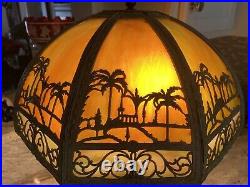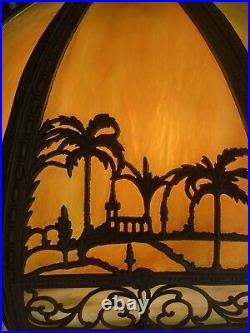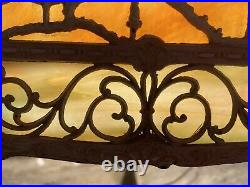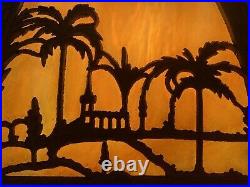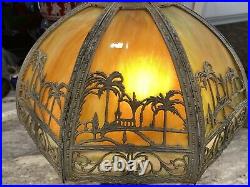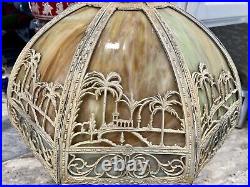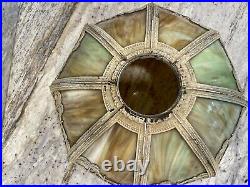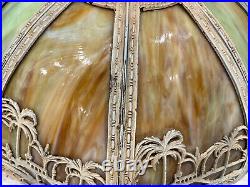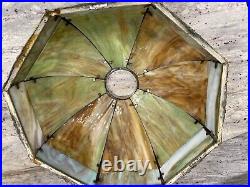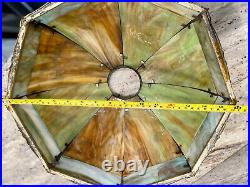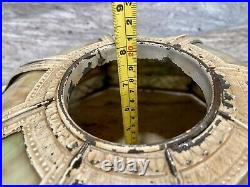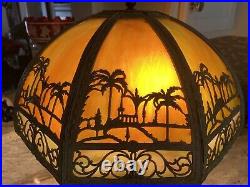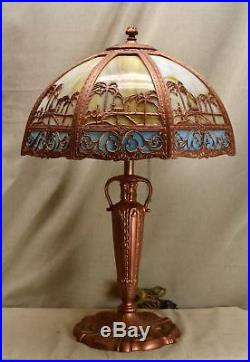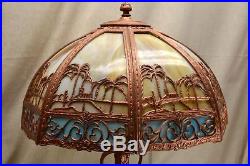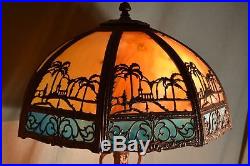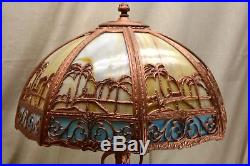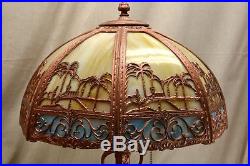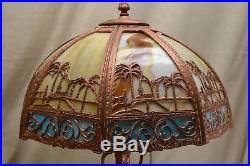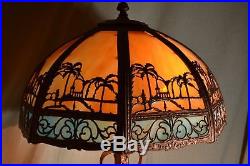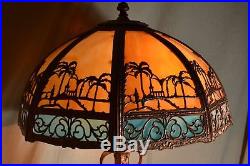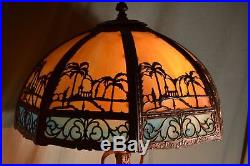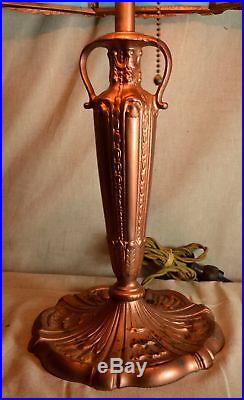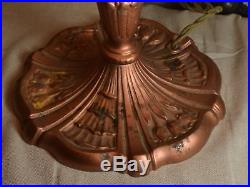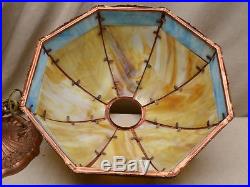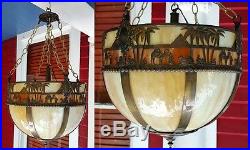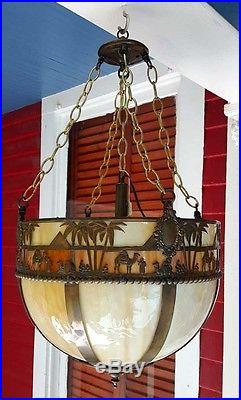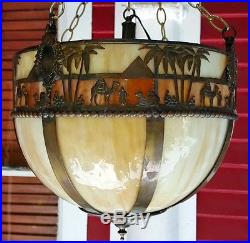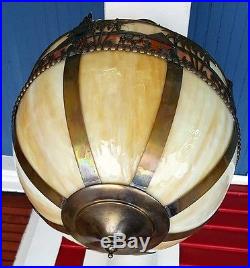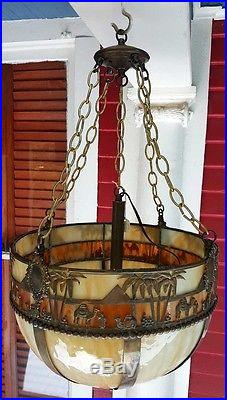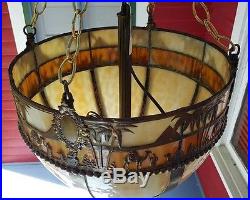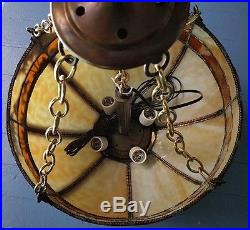Rare Vintage Original Tiffany Meyda Table Lamp Desert Camel Scene Works Great
Rare vintage Tiffany & Co Meyda bronze slag glass pyramid shaped table lamp. Gorgeous desert camel scene. Measures 10″ x 10″ x 8.25. Very good condition and works perfectly. Has on/off switch on electric cord. No cracks in glass.
Antique Slag Glass Lamp Shade, Egyptian Desert Oasis, Handel era
Antique Egyptian Desert Slag Glass Lamp Shade in good condition. Most likely a Miller Co. No broken or missing glass. The outer metal frame has paint loss but looks to be original paint. This listing is for shade only, no base. When lit up this shade is amazing with the color of glass used, a sand color/dark caramel and a lighter green. The shade measures 16 wide and the top opening is 3.25 wide. Please see all photos for best description. The item “Antique Slag Glass Lamp Shade, Egyptian Desert Oasis, Handel era” is in sale since Sunday, December 19, 2021. This item is in the category “Collectibles\Lamps, Lighting\Lamp Shades”. The seller is “route52″ and is located in Jacksonville, Florida. This item can be shipped to United States.
- Model: Egyptian Desert Oasis
- Pattern: Desert
- Type: Lamp Shade
- Brand: Antique
- Style: Egyptian
Antique Howard Miller Scenic Desert Palm Slag Glass Lamp Working Excellent
This lamp has a 16 slag glass panels with caramel (white and tan) upper panels and blue along the bottom. The scene is palm trees and a church with a steeple. This is the same lamp pictured in Quality Electric Lamps by LW Book Sales, page 83. Lamp is cast iron and the shade trim is spelter or lead (white metal). The metal parts have been finished with a bronze color – I do not know if that is original to the lamp or not. The wiring is as I bought it, but as with any electrical item, you should have it checked for safety. CONDITION: Excellent – no damage on shade or lamp – few flaws/finish wear in the paint on the base. MEASUREMENTS: 23 1/2 to top of finial. Shade is 15 3/4″ at the bottom and stands 8″ top to bottom. Base is 8 1/4 wide. VINTAGE: Early 1900′s. My current listings are all fresh estate items. Please take a moment to review. We will NOT mark International packages as “gift”. In addition, the cost of packing peanuts, bubble wrap, tape, labels, and the box itself have all gone up. In the event there is damage on your item, KEEP ALL PACKAGING. Both Post Office and UPS require inspection of the package in order to file a claim. We are committed to making you happy. Powered by SixBit’s eCommerce Solution. The item “ANTIQUE HOWARD MILLER SCENIC DESERT PALM SLAG GLASS LAMP WORKING EXCELLENT” is in sale since Sunday, November 26, 2017. This item is in the category “Antiques\Decorative Arts\Lamps”. The seller is “suellen10″ and is located in Canfield, Ohio. This item can be shipped worldwide.
- Maker: Miller
- Age: 1900-1940
- Country/Region of Origin: United States
- Primary Material: Cast Iron
- Item Condition: Pre-owned
- Shades and Accessories Type: Slag Glass
- Lamp Type: Table Lamps
Stained Slag Glass Dome Ceiling Lamp Camel Desert Palm Pyramid Bronze Elements
STAINED SLAG GLASS DOME CEILING LAMP CAMEL DESERT PALM PYRAMID BRONZE ELEMENTS. ???????????? SCROLL DOWN TO VIEW ALL PHOTOS???????????? THIS MONTH, WE ARE PLEASED TO OFFER MANY FINE ANTIQUE AND COLLECTIBLE ARTIFACTS AND RARITIES FROM MISSISSIPPI AND LOUISIANA ESTATES AND PRIVATE COLLECTIONS. FROM AN OLD NEW ORLEANS, LOUISIANA ESTATE, THIS LAMP EXHIBITS ELEMENTS OF ANTIQUE DESIGN, WITH MORE CONTEMPORARY ELECTRICAL COMPONENTS, WITH A DATE OF PRODUCTION UNCERTAIN. MEASURING AN IMPRESSIVE 16″ DIAMETER OVERALL, WITH A 13″ TALL SHADE BODY, AS SHOWN WITH THE LENGTH OF CHAIN ATTACHED, HANGING 28 FROM A CEILING. NOT YET WEIGHED, BUT LIKELY AROUND 15+ POUNDS, AND QUITE SUBSTANTIAL. BRONZE PATINA METAL ELEMENTS FORM A WIDE BORDER, WITH A LARGE GADROON DESIGN SURROUNDING THE LOWER EDGE. THE SCENE DEPICTS FIGURES OF PYRAMIDS, PALM TREES, CAMELS AND THEIR DRIVERS, AND PERHAPS STACKS OF COCONUTS, ALL IN THE MANNER OF A SAHARAN DESERT SCENE. AT POINTS WHERE CHAINS ARE CONNECTED TO RINGS, SCROLL BORDER HERALDS ARE APPLIED. CURVED CREAM TO TAN/ORANGE SLAG GLASS PANELS ARE FLANKED BY BRONZE PATINA VERTICAL METAL BANDS, WITH A SPLIT HORIZONTAL BAND OF ORANGE AND CREAM SLAG GLASS HIGHLIGHTING THE ELEMENTS OF THE DESERT SCENE. IN THE MANNER OF A REVERSE DOME, A CENTRAL STAFF LEADS TO FOUR BULB SOCKETS. FOUR BRASS PATINA METAL LINK CHAINS DRAPE TO THE LOOPS, WITH A CENTER CHAIN ATTACHED TO THE CENTRAL STAFF, ALL LEADING TO A BRONZE PATINA CEILING CAP, MOUNTED WITH LOOPS. WIRING APPEARS TO BE IN GOOD ORDER, BUT HAS NOT BEEN TESTED THIS LAMP SHOULD BE INSPECTED AND INSTALLED BY A QUALIFIED ELECTRICIAN, OR SOMEONE SKILLED AT SUCH ENDEAVORS. OVERALL, FINE, OLD, VINTAGE CONDITION BEST NOTED BY EXAMINING THE HIGH RESOLUTION SCANNED IMAGES OFFERED. HISTORY & TIPS FOR COLLECTORS OF ANTIQUE LAMPS. When collecting lamps its helpful to understand the timeline for both lighting technology and the artistic and social climate that influenced lighting design. From colonial times to around 1850 candles were used for lighting in the United States. By the late 1700s primitive oil lamps that burned whale oil or lard were being used in addition to candles. When the kerosene oil lamp became available in the 1850s, it was quickly adopted as the new standard. Kerosene lamps were used well into the 1930s, especially in rural areas that didnt have widespread public gas and electric utilities. Meanwhile, in large cities, gas was being piped to light fixtures through walls and ceilings by the early 1800s; kerosene lamps were still being used for portable light. In the 1880s electricity emerged as a practical choice, after the 1879 invention of the first commercially successful light bulb. Table lamps were intended for use as room lighting, not for task lighting like that supplied by a desk lamp or sewing lamp. They can also be of no particular style or embrace elements of multiple styles. During the late Victorian period homeowners were switching over from kerosene to electricity for lighting. Many table lamps from this period were designed to use kerosene, but were later converted for electricity. The classic Victorian lamp style is now called Gone with the Wind, even though the type wasnt made until the 1880s, well after the Civil War. This kind of lamp usually has a short metal pedestal, a glass or metal base containing a font for holding kerosene, and a matching glass shade sitting atop the metal mechanism for controlling the wick. The shade surrounds a clear glass chimney, which protrudes from the top of the shade. Manufacturers of Victorian parlor lamps include The Pittsburgh Lamp, Brass, and Glass Company, Fenton, Fostoria, Handel, and Phoenix. Electric Art Nouveau and Arts and Crafts style lamps originated during the same time period but differed considerably in design. Art Nouveau is all about natural forms, with curved lines and textured surfaces. Think flowers, leaves, fruits, animals, and birds. Art Nouveau was largely a European movement and many stunning lamps from this period are by French makers such as Lalique, Gall, and Daum Nancy. The Arts and Crafts style, less ornate than Art Nouveau, was primarily developed in the United States and the British Isles. Its emphasis was on hand-crafting with close attention to the natural beauty inherent in the materials used to make objects. The most famous practitioner of the Art Nouveau style in the United States was Louis Comfort Tiffany. Tiffany and Company made elaborate stained glass lamp shades, often with floral motifs. Some Tiffany bronze lamp bases were sculpted to look like vines, tree roots, or lily pads. Other companies that made quality stained glass lamps during the early Twentieth century include Duffner & Kimberly, Bradley and Hubbard, Handel, Pairpoint, and Chicago Mosaic. Tiffany experimented with many kinds of art glass and designed other lamps that were nothing like his familiar stained glass style. His patented favrile glass used in the shades was imitated by the likes of glass lamp shade makers Steuben, Quezal, and Durand. The Arts and Crafts movement was typified by Frank Lloyd Wright with his Prairie School architecture and Gustav Stickley with his Mission style furniture. Both Stickley and Wright designed lamps that fit in with their other designs. Arts and Crafts lamps tend to have a solid, geometric look using smooth and straight lines. Bases might be wood, metal, or ceramic. A classic Arts and Crafts lamp is the type made by Dirk van Erp who used hammered copper for a base and thin sheets of translucent mica for his shades. Other famous creators of Arts and Crafts lamps were the Fulper pottery and the Roycroft community. Large lamp manufacturers like Bradley and Hubbard that made Art Nouveau styled lamps also designed lamps in the Arts and Crafts style. Reverse painted lamps feature a design, often a landscape, painted by hand on the inside of a glass shade blank. The paint was then fired into the glass. These lamps were made by Handel, Pairpoint, Moe Bridges, Jefferson, Pittsburgh and others. The Pairpoint puffy is a prized lamp of this type, with molded glass forming design elements like flowers that puff outward. Slag glass lamps have shades with glass panels that fit into ribbed metal frames with various kinds of clips and slots. Sometimes the base also has glass panels. The shade often has a metal design overlaying part of the glass. The glass is frequently an amber or caramel color, but sometimes light blue, pink, yellow, or green. Manufacturers associated with slag glass lamps include Empire Lamp & Brass Mfg. And Edward Miller & Co. As well as Pittsburgh, Handel, and Bradley and Hubbard. Many slag glass lamps are not signed with a makers mark. Keep your purpose in mind. Your standards might be different for a lamp you want to use for light, one that you intend to display without lighting, and one that youre selecting as an example of a particular type. Examine a lamp in stages, reviewing its overall appearance, shade, base, and working parts. First, look at the lamp overall and ask yourself some questions. Does it appeal to your eye in terms of proportion or does the shade seem too large or too small for the base? Does the lamp seem consistent in its design, with shade and base both having characteristics of the same historical period and the same design motif? Many married pieces are on the market with a pairing of base and shade that is not original. Does it look old? Next, look at the shade. If it is glass, check for breaks, cracks, replaced pieces of stained glass, or replaced slag glass panels. If it has a beaded or crystal fringe, check for completeness. If it has metal parts, look for breaks and repairs. Look for a manufacturers name or mark. Inspect the base, using the same approach. Finally, look at the works, the font and wick burning mechanism in a kerosene lamp or the wiring in an electric lamp. If you want an original condition lamp, this is important. Serious collectors will pay a premium for a lamp with all its original parts. If you plan to rewire the lamp to make it useable or safer, this matters little. Silk-wrapped cord and round plugs indicate early wiring that has a better chance of being original to the lamp. The item “STAINED SLAG GLASS DOME CEILING LAMP CAMEL DESERT PALM PYRAMID BRONZE ELEMENTS” is in sale since Tuesday, November 01, 2016. This item is in the category “Antiques\Decorative Arts\Lamps”. The seller is “ponyboynol” and is located in New Orleans, Louisiana. This item can be shipped worldwide.












